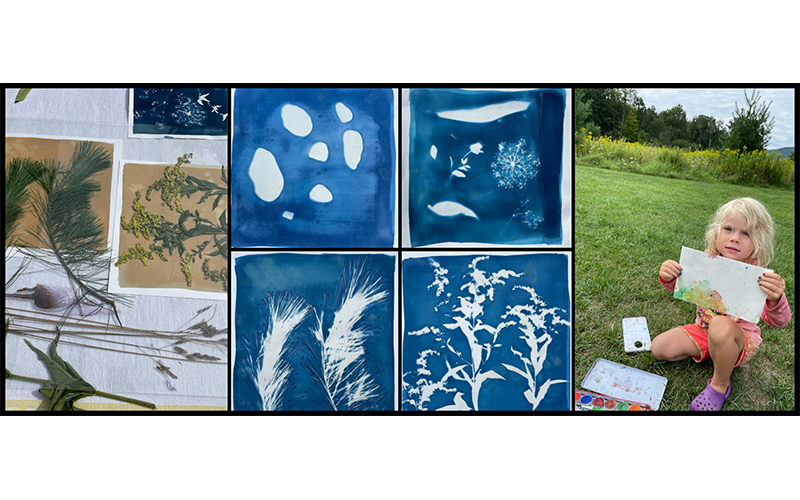On August 21 and 22, teams of Mad River Watch volunteers visited their field sites to collect data and make environmental observations for the sixth and final time this summer. This article is part of an ongoing series that shares highlights from this field work as well as lessons learned from this year and the past 38 years of Friends of the Mad River’s (FMR) Mad River Watch program.
Mad River Watch volunteers collect detailed data about the temperature, conductivity, and pH of the water at their field sites, but they also make a range of observations as well. These observations cover weather conditions, the flow and color of the water, which species of plants and animals live in or pass through the area, and the impact humans have on the river and its tributaries. They are recorded as notes, videos, and photographs and are compiled by FMR staff throughout the season.
“Our volunteers have taken about 1,400 photos since the start of the season,” said FMR stewardship manager Ira Shadis. “The first photos volunteers take during their site visits are a set of four that look upstream and downstream, and at the near and far banks of the river. Volunteers take these photographs from the same location and with the same framing each time so we can document changes, like lower water levels or erosion. Over the long haul, the photos can come together as a kind of flipbook to let us see how the river moves and how the surrounding communities of plants, animals, and people adjust.”
WATCHING THE WEATHER
The water that ends up in the Mad River starts as rain or snow that lands across the watershed. The weather during and leading up to the field day is an important context for understanding the data and observations recorded. “Fewer than one in five of the weather observations made by volunteers included rain,” said Shadis. “One thing that is really interesting about this is that in some cases, a volunteer in Moretown reports blue skies while a volunteer in Warren is out in a downpour. In situations like these, though, we might still see evidence of the rain downstream, through increased flow or changes in water color and turbidity. Overall, though, the volunteers saw a fairly dry summer.” According to the National Integrated Drought Information System, more than 80% of the state of Vermont is experiencing abnormally dry conditions - including the entire Mad River Valley, with the USGS gage discharge at 23 cubic feet per second, which is lower than the 25th percentile of records for the last 93 years – at 33 cubic feet/second.
A LIVING WATERSHED
Mad River Watch field sites span The Valley and showcase just how diverse both the landscape and waterways really are. Nine of the field sites are on the main stem of the Mad River and the other 12 are on tributaries. “From headwater streams so narrow you can hop across them, to the meandering Mad in Waitsfield, to Moretown’s fickle river that is wide and slow then narrow and quick, the watershed is a diverse place,” said FMR director Corrie Miller.
Over the course of the summer, Mad River Watch volunteers have seen and heard many bird species; such as, vireos, robins, house wrens, cardinals, cat birds, goldfinches, blue Jays, chestnut-sided warblers, eastern phoebes, indigo buntings, common yellowthroats, ravens, grackles, juncos, redstarts, black and white warblers, magnolia warblers, song sparrows, red-eyed vireos, cedar waxwings, red-winged blackbirds, mourning doves, and oven birds. Volunteers have also seen signs of other wildlife, including; white-tailed deer, raccoon, trout, salamanders, green frogs, dragonflies, butterflies, mayflies, and crawfish.
“Birds and butterflies were not the only signs of life our volunteers noted,” said Shadis. “As part of an effort to be good stewards of their sites, Mad River Watch volunteers take note of the human use and impact they see.”
One volunteer at a site off North Road in Moretown observed that a, “human-built rock dam has cut off flow from the side channel. Flow was significant in earlier summer, and now it's almost dry.”
Another volunteer at Riverside Conservation Area in Warren noted, “15 people swimming and hanging riverside, lots of rocks rearranged to make pools and dams . . . and someone shared their concern with me about how the fish navigate all the dams people are building in low water.”
The volunteer at Ward Access journaled, “ As my grandsons and I walked the beach at Ward’s, I shared with them how happy it made me to see so many families enjoying the river on such a beautiful, last Mad River Watch day.”
Poetry from the Field
Walking to The River,
By Wilder Rothman
8/21/22, Age 6
I see a yellow goldenrod
turning brown.
I see green, spikey leaves on red stems.
I see a tree,
with brownish red bark and white spots.
It looks like a caterpillar has been here,
there are little holes.
I hear cars on the road,
I hear crickets,
grasshoppers,
or birds.
Tick, tick, tick through one ear.
And, whoooosh through the other.
The air smells hot.
It is sweet.
I smell air,
more air.
The River
By Tulsi Rothman
8/22/22, Age 3
I like to jump at the river.
I see rocks, some brown.
I see sticks with some white dots.
I see a jump rope swing.
That is the orange right there,
up in the tree.
I hear birds; caw ca caw.
I smell the sky.
It smells the same as the planet.
I like to jump at the river.












